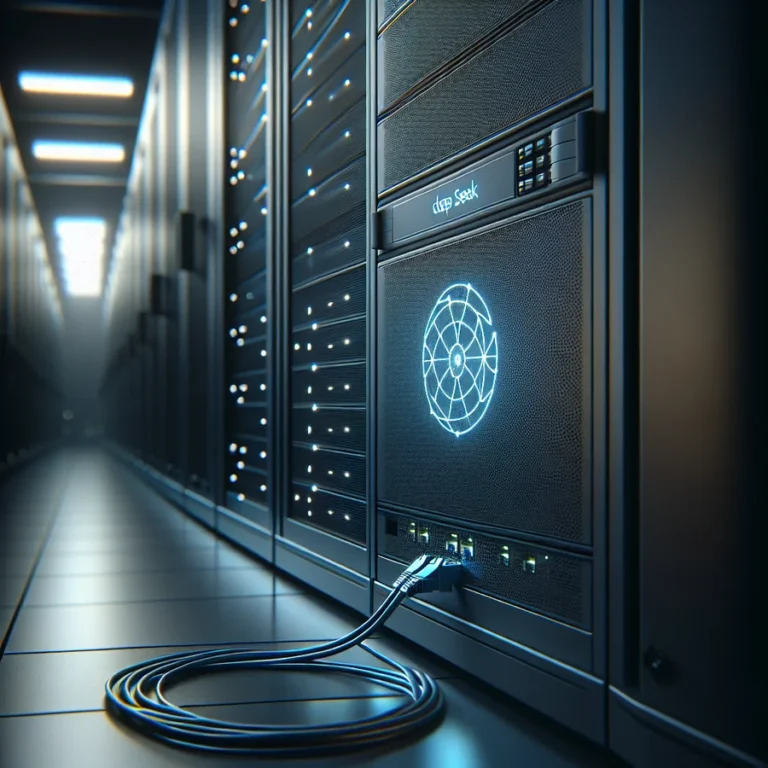DeepSeek AI Slow? Tips to Improve Speed
Is DeepSeek AI feeling sluggish? You’re not alone. Many users are experiencing performance issues. This guide will help you diagnose and fix the problem. We’ll cover everything from hardware limitations to software tweaks. By the end, you’ll have DeepSeek AI running faster and smoother.
DeepSeek AI is a powerful tool. But like any software, it can sometimes run slowly. Don’t worry, there are many ways to boost its speed. Let’s explore how to optimize DeepSeek AI for better performance.
Understanding Why DeepSeek AI Might Be Slow
Several factors can contribute to DeepSeek AI’s slow performance. Let’s break down the most common culprits.
Hardware Limitations
Your computer’s hardware plays a crucial role. A weak processor or insufficient RAM can significantly slow down DeepSeek AI.
- CPU: The central processing unit handles the AI’s calculations. A faster CPU means quicker processing.
- RAM: Random access memory stores the data the AI is currently using. More RAM prevents the AI from constantly accessing the hard drive, which is much slower.
- GPU: The graphics processing unit can accelerate certain AI tasks. A dedicated GPU can significantly improve performance, especially for larger models.
- Storage: While not as critical as CPU, RAM, or GPU, a Solid State Drive (SSD) is preferable to a Hard Disk Drive (HDD). SSDs offer faster read and write speeds, improving overall system responsiveness.
Reminder: DeepSeek AI’s performance is directly tied to your hardware. Upgrading your components can have a dramatic impact.
Software Configuration
The way you’ve configured DeepSeek AI can also affect its speed. Incorrect settings or outdated software can lead to performance bottlenecks.
- Model Size: Larger AI models are more powerful but require more resources. Using a smaller model can improve speed on less powerful hardware.
- Inference Engine: The inference engine is the software that runs the AI model. Using an optimized inference engine can significantly improve performance.
- Operating System: An outdated operating system can lack the necessary drivers and optimizations for DeepSeek AI.
- Drivers: Outdated or incompatible drivers for your CPU, GPU, or other hardware can cause performance issues.
Note: Optimizing your software configuration is crucial for getting the best performance from DeepSeek AI. Understanding common errors like those that cause DeepSeek AI not working and how to fix them can also help.
Network Connectivity (If Applicable)
If you’re using a cloud-based version of DeepSeek AI, your network connection is important. A slow or unstable connection can cause delays.
- Internet Speed: A faster internet connection allows data to be transferred more quickly.
- Latency: Latency is the delay between sending a request and receiving a response. Lower latency means a more responsive experience.
- Network Congestion: High network traffic can slow down your connection.
Reminder: A stable and fast internet connection is essential for optimal performance with cloud-based AI services.
DeepSeek AI Server Load
Even if your hardware and network are perfect, DeepSeek AI’s servers might be overloaded. This is especially common during peak usage times.
- High Traffic: When many users are accessing DeepSeek AI simultaneously, the servers can become overwhelmed.
- Server Maintenance: DeepSeek AI may occasionally perform maintenance, which can temporarily slow down performance.
Note: Server-side issues are beyond your control. However, you can check DeepSeek AI’s status page for updates.
Tips to Improve DeepSeek AI Speed
Now that we understand the potential causes of slow performance, let’s explore some solutions.
Optimize Your Hardware
Upgrading your hardware is often the most effective way to improve DeepSeek AI’s speed. Here’s what to consider.
Upgrade Your CPU
A faster CPU can significantly improve processing speed. Look for a CPU with a higher clock speed and more cores. For example, consider upgrading from an Intel i5 to an Intel i7 or i9, or from an AMD Ryzen 5 to a Ryzen 7 or 9.
Example: Imagine your CPU is a chef. A faster chef can chop vegetables and cook ingredients more quickly, resulting in a faster meal (AI response).
Increase Your RAM
More RAM allows DeepSeek AI to store more data in memory, reducing the need to access the slower hard drive. Aim for at least 16GB of RAM, and consider 32GB or more for larger AI models.
Example: Think of RAM as a chef’s countertop. More counter space allows the chef to keep more ingredients readily available, speeding up the cooking process.
Add a Dedicated GPU
A dedicated GPU can accelerate certain AI tasks, especially those involving image or video processing. Look for a GPU with a large amount of VRAM (video RAM). NVIDIA GeForce or AMD Radeon cards are popular choices.
Example: A GPU is like a specialized kitchen appliance, such as a food processor. It can perform specific tasks much faster than the chef (CPU) alone.
Switch to an SSD
An SSD provides much faster read and write speeds compared to a traditional HDD. This can improve overall system responsiveness and reduce loading times.
Example: An SSD is like having a chef who can instantly grab ingredients from the refrigerator, while an HDD is like having a chef who has to walk to the grocery store every time they need an ingredient.
Optimize Your Software Configuration
Tweaking your software settings can also boost DeepSeek AI’s performance. Here’s how.
Choose the Right Model Size
DeepSeek AI offers different model sizes. Larger models are more accurate but require more resources. If you’re experiencing slow performance, try using a smaller model.
Example: A smaller AI model is like a simpler recipe. It might not be as fancy, but it’s quicker to prepare.
To select a specific model size when using Ollama, use the following commands:
- 1.5B version (smallest): `ollama run deepseek-r1:1.5b`
- 8B version: `ollama run deepseek-r1:8b`
- 14B version: `ollama run deepseek-r1:14b`
- 32B version: `ollama run deepseek-r1:32b`
- 70B version (biggest/smartest): `ollama run deepseek-r1:70b`
Use an Optimized Inference Engine
The inference engine is the software that runs the AI model. Some popular options include:
- Ollama: A tool for running AI models locally. It’s easy to install and use.
- llama.cpp: A C++ library for running large language models. It’s highly optimized for performance.
Note: Ollama labels all the distilled models as “deepseek-r1”, so be aware of the actual model size you are using.
Update Your Operating System and Drivers
Make sure your operating system and drivers are up to date. This ensures that you have the latest performance optimizations and bug fixes.
Example: Updating your OS and drivers is like giving your car a tune-up. It helps everything run smoothly and efficiently.
Adjust CPU Threads
You can control how many CPU threads DeepSeek AI uses. Increasing the number of threads can improve performance, but only up to a certain point. Experiment to find the optimal setting for your system.
To adjust CPU threads, use the `OLLAMA_THREADS` environment variable or the `–num-threads` flag in Ollama.
Example: More threads are like having more chefs working in the kitchen. But if there are too many chefs, they’ll start getting in each other’s way.
Increase GPU Layers
If you have a dedicated GPU, you can offload some of the AI processing to it. This can significantly improve performance. The `–n-gpu-layers` flag in llama.cpp or the `–ngl` flag in Ollama controls how many layers are offloaded to the GPU.
Example: Offloading to the GPU is like having a specialized appliance (like a food processor) take over some of the tasks from the main chef (CPU).
Adjust Batch Size
The batch size determines how many tokens are processed at once. Increasing the batch size can improve throughput, but it also requires more memory. The `–batch-size` flag in llama.cpp controls the batch size.
Example: A larger batch size is like cooking multiple dishes at once. It can be faster, but it also requires more space and resources.
Prioritize DeepSeek AI
You can increase the priority of the DeepSeek AI process so that it gets more CPU time. This can improve performance, but it may also make your system feel less responsive.
Use the `nice -n -20` command in the shell to raise the process priority.
Example: Prioritizing DeepSeek AI is like giving the chef the best ingredients and equipment. It helps them work more efficiently, but it may come at the expense of other tasks.
Manage Context Size
The context size determines how many tokens the model can “remember” in a single chat. A larger context size requires more memory. Keep the context size at the default unless you need longer context or bigger prompts.
Use the `–context-size` flag in Ollama or llama.cpp to adjust the context size.
Example: A larger context size is like having a chef with a better memory. They can recall more details about past dishes, but it also requires more mental effort.
Optimize Your Network (If Applicable)
If you’re using a cloud-based version of DeepSeek AI, optimizing your network connection can improve performance.
- Use a Wired Connection: A wired connection is generally more stable and faster than Wi-Fi.
- Reduce Network Congestion: Close any unnecessary applications that are using bandwidth.
- Upgrade Your Internet Plan: If you’re consistently experiencing slow internet speeds, consider upgrading to a faster plan.
Note: Network optimization is crucial for cloud-based AI services.
Address DeepSeek AI Server Issues
If the problem is on DeepSeek AI’s end, there’s not much you can do directly. However, here are some steps you can take:
- Check the Status Page: DeepSeek AI may have a status page that provides information about server outages or maintenance.
- Try Again Later: If the servers are overloaded, try using DeepSeek AI at a less busy time.
Reminder: Server-side issues are often temporary. Be patient and try again later.
Specific Instructions for Ollama and Open WebUI
If you’re using Ollama and Open WebUI, here are some additional tips to improve performance.
Configure Ollama
Ollama is a popular runtime for running AI models locally. Here’s how to optimize it:
- Set CPU Threads: Use the `OLLAMA_THREADS` environment variable to set the number of CPU threads. For example: `export OLLAMA_THREADS=16`.
- Adjust GPU Layers: Use the `–ngl` flag to specify how many layers to offload to the GPU. For example: `ollama run deepseek-r1:8b –ngl 32`.
Optimize Open WebUI
Open WebUI provides a user-friendly interface for interacting with DeepSeek AI. Here’s how to optimize it:
- Use Docker: Docker allows you to run Open WebUI in a container, which can improve performance and isolation.
- Allocate Resources: Make sure Docker has enough resources allocated to it, such as CPU and memory.
DeepSeek R1 and Raspberry Pi
Can you run DeepSeek R1 on a Raspberry Pi? Technically, yes, but with limitations. The Raspberry Pi can run smaller models, but the performance won’t be stellar.
A Raspberry Pi 5 with an external graphics card can significantly speed things up. A GPU with 16GB of VRAM can make a noticeable difference.
Note: Don’t expect ChatGPT-level performance on a Raspberry Pi. But it can be a fun and educational project.
DeepSeek AI: A Boon for Marketers and a Threat to Big Tech?
DeepSeek AI has shaken up the AI landscape. Its low cost and impressive performance have made it a popular choice for marketers and other professionals. The open-source nature of Deepseek also raises interesting questions about the future of AI and open-source AI models.
However, DeepSeek AI also poses a potential threat to big tech companies like OpenAI. Its open-source nature and accessibility could democratize AI and reduce the dominance of these companies.
Reminder: The AI landscape is constantly evolving. DeepSeek AI is just one example of the exciting new developments in this field.
Conclusion
DeepSeek AI’s speed can be improved through various methods. Optimizing your hardware, tweaking software configurations, and ensuring a stable network are key. While server-side issues are sometimes unavoidable, understanding these factors empowers you to enhance your AI experience. By implementing these tips, you can unlock the full potential of DeepSeek AI and enjoy a faster, more efficient workflow. If you are a content writer, you can also explore how Deepseek AI is changing content creation.
FAQs
Why is DeepSeek AI so slow?
DeepSeek AI can be slow due to several factors, including hardware limitations (CPU, RAM, GPU), software configuration (model size, inference engine), network connectivity (if applicable), and DeepSeek AI server load.
How can I make DeepSeek AI run faster?
You can improve DeepSeek AI’s speed by upgrading your hardware (CPU, RAM, GPU, SSD), optimizing your software configuration (choosing the right model size, using an optimized inference engine, updating your operating system and drivers), optimizing your network (if applicable), and addressing DeepSeek AI server issues (checking the status page, trying again later).
What is the best hardware for DeepSeek AI?
The best hardware for DeepSeek AI includes a fast CPU (Intel i7/i9 or AMD Ryzen 7/9), at least 16GB of RAM (32GB or more for larger models), a dedicated GPU (NVIDIA GeForce or AMD Radeon), and an SSD.
How do I choose the right model size for DeepSeek AI?
Choose the model size based on your hardware and needs. Larger models are more accurate but require more resources. If you’re experiencing slow performance, try using a smaller model.
What is an inference engine?
An inference engine is the software that runs the AI model. Popular options include Ollama and llama.cpp.
How do I update my operating system and drivers?
The process for updating your operating system and drivers varies depending on your operating system. In general, you can find updates in the system settings or by visiting the manufacturer’s website.
How do I optimize my network for DeepSeek AI?
You can optimize your network for DeepSeek AI by using a wired connection, reducing network congestion, and upgrading your internet plan.
What can I do if DeepSeek AI’s servers are overloaded?
If DeepSeek AI’s servers are overloaded, you can check the status page and try again later.
What is Ollama?
Ollama is a tool for running AI models locally on your machine.
What is Open WebUI?
Open WebUI provides a user-friendly interface for interacting with DeepSeek AI.






